Fascinating world of CW, SSTV and Digital Radio
CW and analog radio-telephony speech modulation like AM, FM or SSB played a predominant role during the first 100 years of radio communication. Pictures were also transmitted over radio using radio-facsimile or APT analog raster scans. Amateur radio operators used similar raster scan picture transmissions called SSTV (Slow Scan Television). They were actually still pictures scanned and transmitted over narrow HF base-bands as permitted on HF spectrum. Perhaps the only truly digital radio mode text transmission during this era was RTTY (Radio Teletype). Of course, various other digital modes were being experimented but it was only later that other digital mode became popular.
Digital radio modulation methods started becoming popular during the late 20th century and started giving tough competition to CW which was the mainstay of narrowband, weak-signal communication till then. Personal computers and micro-controllers made this possible. Earlier, prior to the proliferation of PCs, it was too cumbersome to encode/decode and modulate/demodulate digital information for radio transmission. Digital radio modulation modes offer new avenues for communication using various modes and protocols. At times, there is definitely a distinct advantage offered by digital modulation methods.
 CW – Radiotelegraphy
CW – RadiotelegraphyCW or Radio-telegraphy was undoubtedly the first form EM wave modulation ever done to carry meaningful information over the radio. Even today, it is perhaps the most robust and reliable mode of radio communication available to mankind. CW is the simplest form of modulation which requires the least amount of hardware in terms of complexity for both transmitting as well as receiving. moreover, it has the ability to work effectively and reliably under weak signal and adverse propagation conditions.
It occupies a very narrow bandwidth of the radio spectrum. CW (radio-telegraphy) is transmitted in Morse Code. It is a form of On/Off keyed code consisting of a sequence of short and long bursts of transmissions (called dit and dah) developed by Samuel Morse. The unique combination of the dits and dahs represents each character in the English language alphabet. Any person who has learned morse code (CW) is capable of transmitting CW using a simple electric On/Off key known as Morse key. On the receiving side, these sequential bursts of RF transmission can be heard as a beat tone and sound very musical to the ear.
A trained CW operator can mentally decode the CW tone sequence by the ear to form words and sentences in the mind. Nowadays several software applications are available to convert CW tone to text on a computer screen. However, the combination of the human ear and the brain is far superior than most of these software when it encounters a noisy and a weak signal HF radio environment with deep fading and multi-path propagation.. Read More.
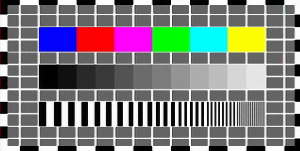 Slow-Scan Television – (SSTV)
Slow-Scan Television – (SSTV)Slow-scan television (SSTV) is a mode of communication designed for image transfer. Because SSTV is a narrowband mode compared to normal TV, it can be transmitted via voice channels with a standard SSB transceiver on all radio amateur frequency bands. Worldwide communication is also possible during good conditions on high-frequency bands.
The basic idea of SSTV is to transfer television images with the standard transceiver. However, a television broadcast requires a large bandwidth. The reduction of signal bandwidth is achieved by lowering of horizontal and vertical scans, which must be reduced to a minimum acceptable rate suitable for narrow baseband transmission. This means that a typical 5.5-6 MHz signal bandwidth of color broadcast television must be reduced to around 3 kHz. This amounts to a required reduction of bandwidth by a ratio of around 2000:1. This is the primary technical difference between commercial TV broadcast which is Fast-scan television (FSTV) and the SSTV used over HF radio.
As a consequence, unlike broadcast TV, only static images with lower resolution can be transferred due to this huge reduction of bandwidth. However, with the technological advancements in software and digitalization methods, nowadays, Digital-SSTV has also been developed which uses advanced technologies like data compression, error correction codes and discrete multi-tone modulations for relatively fast narrow-band data transfer resulting in reliable transmission of crisp and clean SSTV pictures over HF radio… Read More.
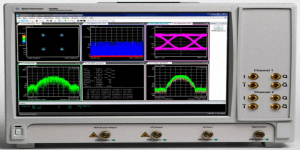 Digital modulation fundamentals
Digital modulation fundamentalsDigital radio Modulation is a term used to refer to the way of modulating a binary digital bitstream for transmission over a medium like radio wave. Most radio communication systems like a radio transmitter are only capable of modulating analog signals. This is also true for amateur radio transceivers.
Therefore, a binary digital bitstream has to be first modulated on to a low-frequency subcarrier so that the entire bitstream modulated analog subcarrier is contained within the baseband limits of the radio transceiver (TXR). This process is usually carried out in software running on a personal computer. The modulated subcarrier thus generated is fed into the TXR through its audio input port. Thereafter the TXR processes the digitally modulated subcarrier baseband input in a manner similar to a normal microphone input.
On the receiving end, the TXR demodulates the carrier to retrieve the baseband subcarrier which is thereafter fed to a PC software at the receiving end which demodulates the subcarrier and produces a replica of the original digital bitstream. Primarily, there are three different methods available for subcarrier modulation based on three distinctive parameters of a sinusoidal waveform. They are amplitude, frequency, and phase. Hence, we can either do amplitude shift keying (ASK), or frequency shift keying (FSK), or phase-shift keying (PSK).
Of course, there are other methods too, which involve combining any two of these methods to produce other exotic digital modulation protocols like quadrature amplitude modulation (QAM), or other M-ary modulations… Read More.
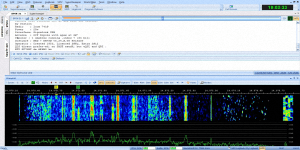 Text & Data Mode Radio
Text & Data Mode RadioOther than classic radiotelegraphy (CW), radiotelephony (SSB, AM, FM, etc.), and the less in vogue digital radiotelephony which uses ADC digitised voice bitstream subcarrier modulation; amateur radio extensively uses digital radio modes (Digi-modes) for transmission of text and data over HF radio medium.
Unlike CW and radiotelephony, Digi-mode signals cannot be produced or deciphered without the aid of a machine. The machine may be electromechanical/electronic hardware or a computer running appropriate software. This is the fundamental distinction between classic and Digi-modes of communication. Usually, most Digi-modes are designed for text communication while some modes can also transfer files. All digital radio text modes are bandwidth-efficient and operate over very narrow noise integration bandwidth. Hence several separate transmissions can simultaneously coexist in a space occupied by a single SSB transmission.
There are three generations of Digi-mode protocols that are popular amongst amateur radio operators. The oldest being the first-generation Digi-modes like RTTY, AMTOR, PACTOR, etc. The second-generation modes are more efficient and often use forward error-correcting algorithms. Some of these are PSK31, MFSK, QPSK, MT63, THOR, Throb, DominoEX, Hellschrieber, Olivia, Contestia, etc. Another interesting mode is ROS with excellent performance under weak signal and low SNR conditions. All these modes are conversational modes that allow free-form text transmission and are suitable for conducting engaging QSOs and rag-chews as well. Many of them can work very well with low TX power (QRP), moderate antennas and marginal propagation conditions.
The third-generation of Digi-modes are the new kids around the block. Some of these are JT65, JT9, JT4 FT8, etc. Since the year 2018, the FT8 and JT65 (to a lesser extent) have taken the ham radio world by storm. These modes have the ability to work with QRP under very poor propagation conditions. However, there is never a free lunch. These modes are very slow and take as long as 15 seconds to a minute to transmit just callsign, grid-square, and RST report. That is why these modes do not allow any free-form text messages. They only send and receive pre-structured and non-editable message blocks to conduct QSO. When you see a CQ call on screen, all that you need to do is to click on the call and the software can do the rest by automatically conducting the rest of the QSO and even sign-off and make automatic logbook entry.
Although, these are marvels of technology, but in my opinion, unlike the 1st and 2nd generation modes which allow free-form text, they are rather restricted, boring, and zombie-like… Read More.
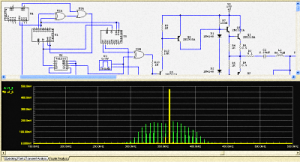 Spread Spectrum (DSSS & FHSS)
Spread Spectrum (DSSS & FHSS)Spread Spectrum (SS) technology is used to spread out and distribute the modulated signal power across a much wider frequency spread than what is natively needed for the particular modulation mode. The spreading of energy distribution over a wider spectrum results in very low spectral power density. This means that the modulated digital radio signal can now even be well below the noise floor yet produce a strong signal at the receiver after the reverse process of despreading is done. Hence, SS signals are less prone to the effects of QRM caused by interfering stations and other forms of QRM.
Moreover, SS is also a secure mode of communication since the spreading sequence is defined by a key which needs to be identical at the RX end for effective despreading and recreation of the original baseband. There are two distinct types of SS. The Frequency Hopping Spread Spectrum (FHSS) and Direct Sequence Spread Spectrum (DSSS). The spreading key for FHSS consists of a table of frequencies, whereas, the key for DSSS is a multi-bit pseudo-random binary sequence (PRBS). One of the real application examples of DSSS is its use in the GPS signals that we regularly encounter in life for geo-location purposes. DSSS is very well suited for use in amateur digital radio on all bands including HF.
Although military communication systems around the world extensively use both forms of SS, the fact of the matter is that amateur radio has been generally deprived of using these wonderful modes. The reason being that the communication regulatory agencies across nations have been rather paranoid and have refused to allow SS for amateur service because of the notion that it can be misused since SS is capable of stealth communication by simply altering the spreading sequence key, Therefore, it might not be easy to monitor traffic content. Though a few experimental SS digital radio license endorsements have been issued to a select few amateur operators from time-to-time but a general approval for regular amateur use has never been granted... Read More.
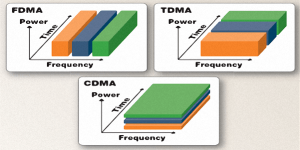 Multiple Access (FDMA, TDMA & CDMA)
Multiple Access (FDMA, TDMA & CDMA)Multiple Access or multiplexed radio communication systems refer to methods by which several separate and distinct conversation channels can be modulated over a single RF carrier and at the receiving end they can be demodulated simultaneously to reproduce the contents of each and every channel without causing interference to one another. Although multiplexed analog as well as digital radio radio communication is not applicable to amateur radio and hence may not be of general interest to the amateur community, nevertheless, we have included it here purely for academic interest.
The multiple access technology fundamentally works in three different ways. They are Frequency Division Multiple Access (FDMA), Time Division Multiple Access (TDMA), and Code Division Multiple Access (CDMA). The earliest multiple access methods that were used was FDMA which is essentially a totally analog process where each conversation channel is first modulated on to separate adjacent channel subcarriers which are all modulated on a common carrier to produce a single modulated wide-spectrum channel containing all the constituent sub-channels for transmission over the radio medium. The reverse process of carrier demodulation followed by individual subcarrier demodulation is done at the receiver end. FDMA has the shortcoming of requiring a large number of sharp and precisely tuned filters at both the transmitter and the receiver thus making it a cumbersome system.
The advancement of digital signal processing technologies later made TDMA more popular since the entire signal processing chain required for multiplexing was a digital process of allocating fixed time slots for transmission for each channel in a sequentially repetitive manner for creating a multiple access system. The cumbersome filters got eliminated and the entire process became more-or-less totally digital. Therefore it became easier to replicate, manufacture and maintain the TDMA system.
The latest multiplexing system to achieve multiple access is CDMA. This uses Direct Sequence Spread Spectrum (DSSS). Like all other multiple access methods CDMA also uses a common radio frequency to accommodate multiple conversation channels. However, it does so, neither by stacking channels together in the frequency domain like FDMA nor does it do it by splitting slots in time domain like TDMA. A unique method is applied for CDMA where the entire allocated spectrum is used from end-to-end by every channel after being subjected to spreading achieved through DSSS.
Hence all channels overlap each other both in time and frequency, yet they retain their isolation from one another and do not cause cross-channel interference. This is possible due to the use of unique PRBS spreading codes for each DSSS channel. These spreading codes also known as Chip code are selected carefully from a set of Kasami codes or Gold codes for asynchronous CDMA or Walsh code for synchronous CDMA. TDMA is used in mobile GSM systems while CDMA is also used in several CDMA mobile phone networks. Satellite bulk traffic telephone communication extensively use linear transponders along with one or more of these types of multiple access protocols... Read More.
List of Articles under this Section
CW Radiotelegraphy - A Robust mode CW Radiotelegraphy - A disaster surviveable mode CW Radiotelegraphy is the oldest mode of radio communication and yet perhaps the most robust mode available to mankind to date. CW Radiotelegraphy is an adaptation of the cable telegraphy...Learn CW Morse Code - Get Started Learn CW Morse Code - Get Started If you are reading this article, then in all probability you either wish to learn CW Morse Code from the scratch or are one of those who learned it earlier in life but still find it an uphill task...Learn CW Morse Code - Lesson Set 1 Learn CW Morse Code - Lesson Set 1 This article on Learn CW Morse Code - Lesson Set 1 is the first in our series of lesson sets for beginners and perhaps others too, to learn Morse code on the journey to becoming a proficient...Learn CW Morse Code - Lesson Set 2 Learn CW Morse Code - Lesson Set 2 This is Lesson Set -2 in our multi-part series of CW Morse Code hands-on tutorials where we will introduce numerals and a few important punctuation marks as per International Morse Code standards...Slow Scan TV (SSTV) - How it works Slow Scan TV (SSTV) - Analog and Digital Slow Scan Television or SSTV is essentially a derivative of the wideband broadcast television system that we are so familiar with. The fundamental principles of SSTV signal structure and...Digital Modulation Fundamentals The fundamentals of Digital modulation for radio The 21st century has seen a major upsurge of digital modulation methods in radio communication. It is, therefore, imperative for all amateur radio operators to attain a clear insight...Data & Text Mode digital Radio Data & Text mode Digital Radio Communication Data and Text mode digital radio communication has matured over the decades and now forms an important aspect not only of professional and commercial radio but is also an integral part...














